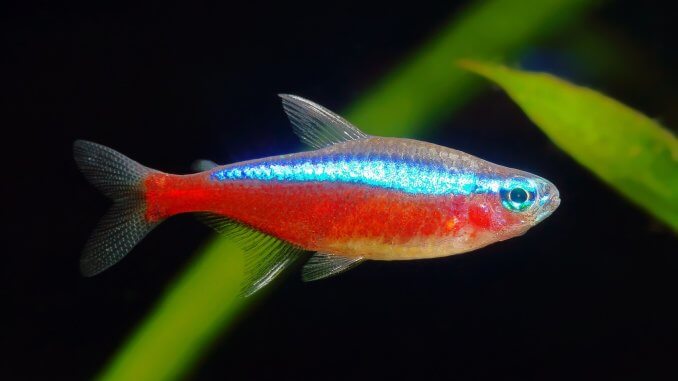
The cardinal tetra is a small freshwater fish of the tetra fish family.
Cardinal tetras grow up to two inches and are popular among aquarists because of the fish’s captivating colors and peaceful nature. These fish are active and ideal for community tanks.
Cardinal tetras are often mistaken for neon tetras due to their similar appearance.
TABLE OF CONTENTS
Cardinal Tetra Facts & Overview
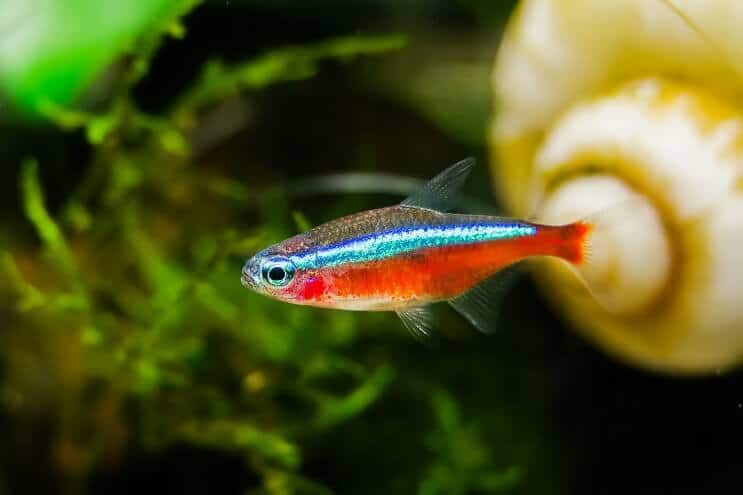
| Scientific name: | Paracheirodon axelrodi |
| Common names: | Cardinal tetra, red neon tetra, scarlet characin |
| Distribution: | Brazil, Colombia, Venezuela |
| Size: | 2 inches |
| Life expectancy: | 4–5 years |
| Color: | Bright coloring, red, iridescent blue stripe |
| Diet: | Omnivore |
| Temperament: | Peaceful |
| Minimum tank size: | 20 gallons |
| Temperature: | 73–81°F (23–27°C) |
| pH: | 4.6–6.2 |
| Hardness: | Up to 4 dGH |
| Care level: | Intermediate |
| Breeding: | Egg layers |
Origin
The cardinal tetra (Paracheirodon axelrodi) is native to the Orinoco and Negro River drainages in South America, which span across Brazil, Colombia, and Venezuela.
Cardinal tetras inhabit blackwater creeks and tributaries in the wild. These bodies of water are soft, acidic, and colored black from the tannins of decaying leaves.
The cardinal tetra is prolific in the wild, and most cardinal tetras in the pet trade are wild-caught.
Adult Size & Lifespan
Mature cardinal tetras reach two inches in length, with an average mass of 0.13 grams. Females are bigger than males.
Cardinal tetras have an average life expectancy of between four and five years in captivity, although some cardinal tetras have lived for up to 10 years. In the wild, these fish have an average lifespan of one year.
Well-fed cardinal tetras living in ideal tank parameters are more likely to experience long lives.
Availability
Cardinal tetras are readily available in pet stores across the world. A cardinal tetra costs between $3 and $5 on average. A school of six cardinal tetras costs around $27.
You can buy cardinal tetras at LiveAquaria and Aquatic Arts.
Appearance & Behavior
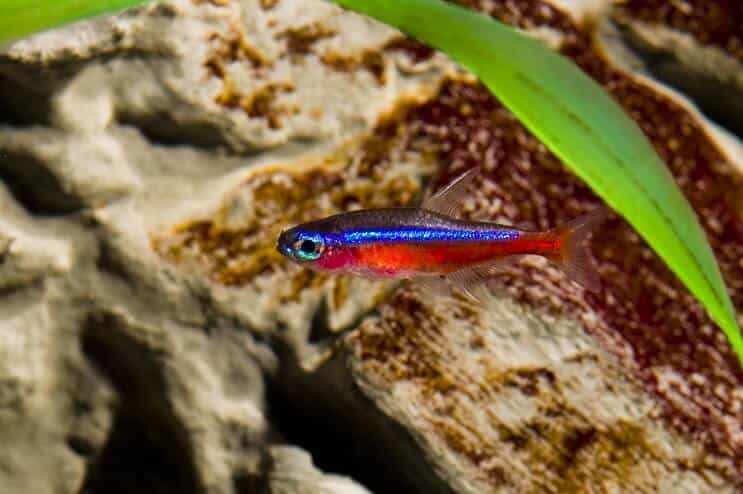
Cardinal tetras are popular with fishkeepers because of their iridescent colors and neon blue stripe. The cardinal tetra is peaceful and playful, and exhibits schooling behavior.
Colors, Patterns, Fins, and Sex Differences
Cardinal tetras are small, spindle-shaped fish. The cardinal tetra gets its name from its vibrant, red coloring and iridescent neon blue lateral stripe that runs from nose to tail. It has a blunt nose and translucent fins.
The color of the cardinal tetra’s lateral stripe changes depending on the light conditions. When resting at night, cardinal tetras lose their dazzling colors. A lack of coloration during daytime indicates stress or illness.
Female cardinal tetras are larger and have more noticeable bellies than males. A hook protrudes from the male’s anal fin.
There are a few varieties of the cardinal tetra, including the gold cardinal tetra and albino cardinal tetra.
- Albino cardinal tetra: White, transparent body. Most albino cardinal tetras lack the iconic stripes, though some retain the red stripe.
- Gold cardinal tetra: Opalescent body with more subdued coloration than standard cardinal tetras.
Cardinal tetras look similar to neon tetras and are often called red neon tetras. Cardinal tetras have more red coloration and a brighter blue stripe than neon tetras.
Typical Behavior
The cardinal tetra is a docile, social schooling fish that’s most active during the day. Cardinal tetras are fast swimmers and spend most of their time in the middle and top of the tank.
The fish enjoys exploring in caves and between plants.
Cardinal tetras are happiest and show their best coloring in schools of at least six. They are rarely aggressive and are only territorial during breeding.
Cardinal Tetra Care & Tank Requirements
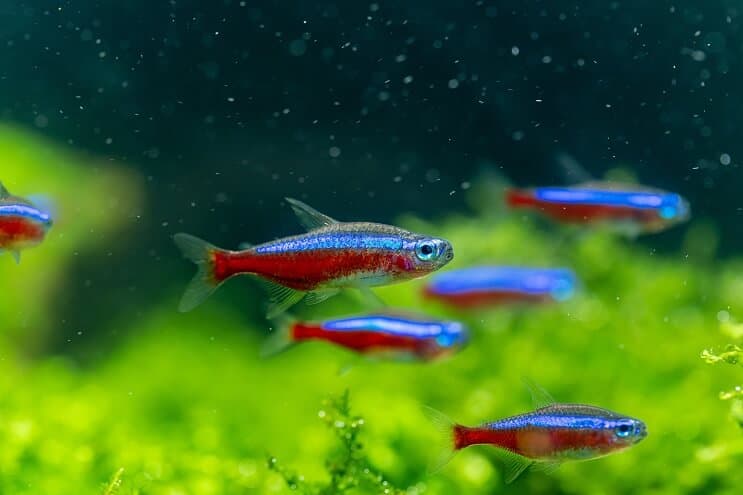
Cardinal tetras are moderately difficult to care for because these fish are more sensitive to water fluctuations than other tetra species.
These fish thrive in groups and do best in a tank setup that matches their natural habitat.
This tetra species is an omnivore and requires a varied, nutritious diet. Feed cardinal tetras a mix of live and frozen foods, pellets, flakes, and vegetables.
Habitat and Tank Requirements
In the wild, the cardinal tetra inhabits blackwater creeks with a substrate of branches, roots, and leaf litter. The water is stained from tannins, and dense rainforests keep the area shaded and dim.
Replicate the cardinal tetra’s preferred living environment with leaf litter, dim lighting, and soft water. Don’t add cardinal tetras to newly cycled tanks.
Tank Conditions
Ideal tank conditions for cardinal tetras include the following:
| Water type: | Freshwater, partial water changes weekly (25%). Cardinal tetras can’t tolerate poor water conditions |
| Tank size: | 20 gallons for a small school of six cardinal tetras. Increase size by around 2 gallons per fish. An elongated tank shape gives cardinal tetras more space to roam and explore |
| Water temperature: | 73–81°F (23–27°C) |
| Substrate: | A dark, sandy substrate with driftwood and roots is ideal and lets the cardinal tetras’ beautiful colors shine |
| Tank setup: | A biotope tank setup is ideal. Tank should be spacious, with enough open space for the cardinal tetra to exhibit schooling behavior. Incorporate caves and branches to replicate the fish’s natural habitat and provide hiding spots Invest in a secure lid for the aquarium. Cardinal tetras jump out of the tank, particularly when feeling stressed or scared |
| Acidity: | Opt for a pH level between 4.6 and 6.2, with 5 being the preferred pH level |
| Water hardness: | Hardness of up to 4 dGH. Cardinal tetras are accustomed to very soft water in the wild |
| Filter: | A filtration system that generates a slow to moderate current can help replicate the waters these fish are used to in the wild |
| Bubbler: | Not necessary as cardinal tetras can tolerate water with low oxygen levels |
| Lighting: | Cardinal tetras need dim lighting. Exposure to harsh lighting can cause stress and ruin the fish’s coloration |
| Plants: | Add aquatic plants that thrive in dim lighting, such as java moss and cryptocoryne Cardinal tetras prefer blackwater environments, which can be created by scattering dried leaf litter at the top of the tank. Replace leaf litter every few weeks to prevent waste buildup Floating plants help keep the tank dim and dark |
After the appropriate tank parameters have been set, ensure the conditions are maintained. Water fluctuations can cause cardinal tetras to become sick. Check the water temperature with a thermometer and the pH level with a pH meter.
Disease
There are many common freshwater diseases that affect cardinal tetras, including ich, fin rot, and dropsy. Cardinal tetras are prone to neon tetra disease.
Neon tetra disease is a deadly generative disease caused by the parasite Pleistophora hyphessobryconis. The disease occurs when the fish consumes infected live foods or dead fish that harbor the parasite. The parasite eats its host from the inside out. The disease spreads through the tank rapidly.
Symptoms of neon tetra disease include restlessness, coloration loss, cysts or a lumpy appearance, and a change in swimming patterns. Secondary infections may appear as a result of neon tetra disease, like fin rot.
There is no cure for neon tetra disease, and most fish need to be euthanized. Fish with neon tetra disease must be quarantined immediately to stop the spread.
To avoid neon tetra disease, buy fish from reputable sellers, keep water well-maintained, and buy live and frozen fish food from trustworthy stores. New fish should be quarantined for two weeks.
Tank Mates
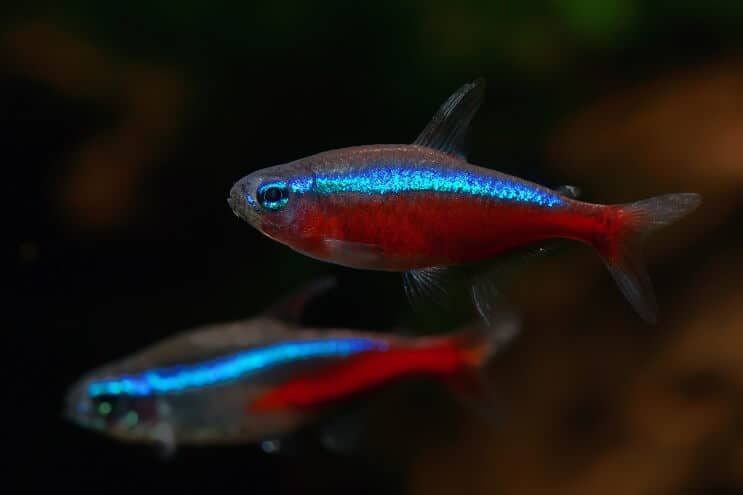
The cardinal tetra is a peaceful and social schooling fish that thrives with its own kind in groups of six or more. Cardinal tetras make wonderful additions to community tanks with similar-sized, docile species.
Suitable tank mates for cardinal tetras include:
- Small tetras with a similar temperament (such as neon tetras)
- Pencil fish
- Hatchet fish
- Rasboras
- Dwarf gouramis
- Barbs
- Corydoras catfish
- Freshwater shrimps, crabs, and snails
Cardinal tetras shouldn’t be housed with boisterous fish or large fish that can fit cardinal tetras in their mouths. Avoid bettas, cichlids, and angelfish.
Other fish to avoid include long-finned fancy fish because cardinal tetras are fin nippers.
Diet and Feeding
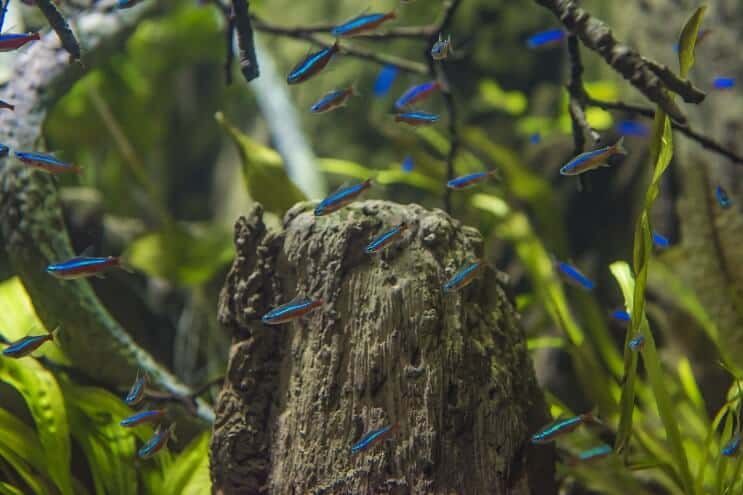
Cardinal tetras are omnivores and feed on worms and small crustaceans in the wild.
Feed cardinal tetras a varied and nutritious diet consisting of pellets, flakes, vegetables, and live or frozen food such as bloodworms, mosquito larvae, and daphnia. Live food improves the cardinal tetra’s coloration.
Suitable vegetable options include peas, cucumber, and broccoli.
Most of the cardinal tetra’s diet should consist of high-quality flakes because the fish requires a high vitamin diet.
Cardinal tetras should be fed two to four times daily. Ensure food is an appropriate size, and only give cardinal tetras an amount they can consume within three minutes to prevent overeating.
Breeding
Cardinal tetras are difficult to breed in a home aquarium, but not impossible. These egg-laying fish require a separate breeding tank and should be monitored closely when spawning.
- Condition the cardinal tetra pair for breeding. Feed the pair live food, and gradually increase water temperature by a few degrees. Ensure water is tannin-rich by adding leaf litter into the tank.
- Set up a 5-gallon breeding tank. The water should be shallow and at least 75°F, with dim lighting, a hardness of 1–2 dGH and a pH between 5.5 and 6.0.
- Incorporate fine-leaved plants like Java moss and spawning mops to provide a place for the female cardinal tetra to deposit her eggs.
- Add an air-powered sponge filter that won’t generate a strong current or suck in the fry.
- A female cardinal tetra becomes plump when full of eggs. Once this occurs, move the pair into the breeding tank.
- Spawning usually takes place in the evening and takes several hours. A female cardinal tetra produces 130 to 500 eggs on average.
- Remove the parents once the egg-laying is finished. Otherwise, the cardinal tetra pair will eat the eggs.
- Eggs hatch after a day, and cardinal tetra fry become free-swimming within four days. Feed fry liquid food or infusoria, then move the fish onto baby brine shrimp after a couple of weeks.
If a pair doesn’t engage in mating behavior, repeat the process with a different pair. Finding a compatible cardinal tetra pair is difficult and takes time.
Should You Get a Cardinal Tetra for Your Aquarium?
Cardinal tetras are peaceful, social fish that are suitable for small aquariums and community tanks.
You should get a cardinal tetra if you have a tank environment that’s acidic, soft, rich in tannins, and spacious enough for cardinal tetras to show off their schooling displays.
Inexperienced fishkeepers should avoid cardinal tetras if they intend to breed the fish.
With the right care and tank setup, cardinal tetras are wonderful fish that keep the tank lively with their captivating swimming patterns and iridescent hues.

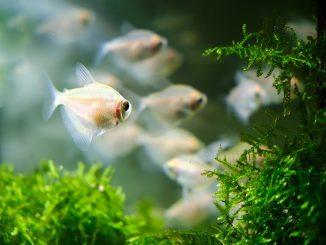

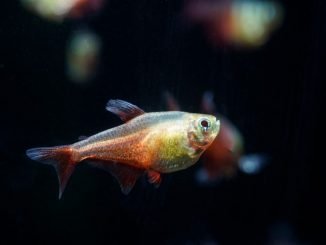
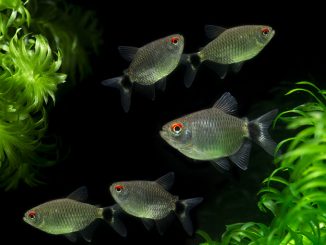

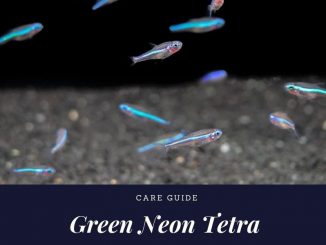
Excellent information
Angelfish can and will eat smaller cardinals..